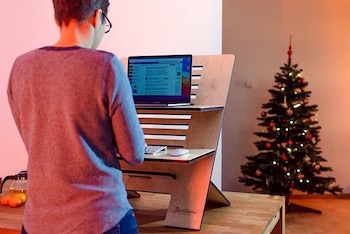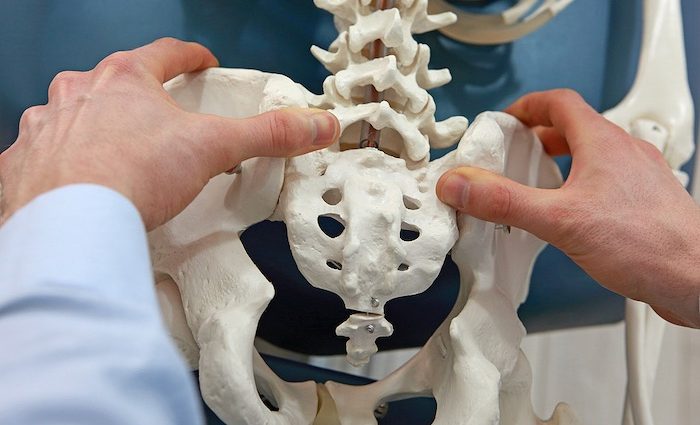One of the things writers have to be concerned about is sitting too much.
I’ve written a lot about this on Writing and Wellness. That’s because it can lead to a lot of problems, including:
- Back pain
- Neck pain
- Shoulder pain
- Hip pain
- Knee pain
- Circulation problems
- Swelling (edema)
- Fatigue
- Hunchback
- Weight gain
- Metabolic syndrome
Sitting too much has even been connected to premature death.
After writing for over 20 years, I’ve experienced a lot of these issues (minus death, thank goodness!), the worst of which has been lower back pain. If you’re having similar trouble, I have some suggestions in this video on tools to help you write pain-free.
Recently, however, I experienced a new pain I hadn’t experienced before. It’s related to lower back pain, but it’s not quite the same: tailbone pain.
Here’s more about why you may be at risk for the same type of pain, and what you can do to prevent and treat it.
 What is Tailbone Pain?
What is Tailbone Pain?
Tailbone pain is different from lower back pain. Rather than occurring in the lumbar area—where the arch in your back is—it occurs lower, where the tailbone is.
Doctors call the tailbone the “coccyx,” which comes from the Greek word for “cuckoo” as the bone resembles a bird’s beak with the tip pointed down.
The coccyx is made up of three to five vertebrae and sits at the very bottom of the spine. These vertebrae are typically fused—or at least semi-fused—by disc-like ligaments, so that they appear as one bone.
The coccyx connects with the next bone up in the spine, which is the sacrum, through the sacrococcygeal joint. There is limited movement between these two.
 What Tailbone Pain from Sitting Too Much Feels Like
What Tailbone Pain from Sitting Too Much Feels Like
Tailbone pain feels different from lower back pain. Lower back pain occurs in the lumbar area and may feel achy or create electric, seizing pains that limit mobility.
Tailbone pain can also feel achy, but more often, it tends to create sharp pain during certain activities. When you get up from a sitting position, for instance, you may feel a stab of pain.
After standing for long periods, the same can happen. Some people report feeling pain at other times too, such as when having a bowel movement or engaging in intercourse.
Activities like driving, writing (whether sitting or standing), bending over, and sleeping can all become painful and much more difficult when you’re suffering from tailbone pain.
I noticed particularly that it made it harder to sleep—even harder than back pain did at times. If you’re suffering from back pain, you can put a pillow between your knees to lessen the pressure when you’re on your side or put it under your knees when lying on your back. (Sleeping on your stomach is usually too painful.)
With tailbone pain, though, none of these adjustments seem to help much.
 How Sitting Too Much Can Lead to Tailbone Pain
How Sitting Too Much Can Lead to Tailbone Pain
If you happen to fall on your tailbone, that can cause trauma and pain. Vaginal childbirth and degenerative joint changes can also lead to this sort of pain, as can strain to the muscles and ligaments around the tailbone, often caused by certain sports like cycling or rowing.
But the most common cause for writers is sitting too much. Just that alone can lead to tailbone pain. Include the following factors, and you may be more at risk:
- Using a chair with a hard surface
- Sitting on a narrow or small surface
- Adopting poor posture (particularly when writing and working at the computer)
- Spending too much time in a bad (hard or non-ergonomic) chair
- Being overweight (it puts more pressure on your coccyx when sitting)
- Being very slim (you lack cushioning around the coccyx so sitting hurts!)
- Sitting as you get older (age wears down the small discs that hold the bones of the coccyx together)
- Reclining too much (it puts more pressure on the tailbone than sitting upright)
 Why Sitting Too Much Strains the Coccyx
Why Sitting Too Much Strains the Coccyx
The problem is that the coccyx is one part of a three-part support system for us when we’re sitting. Our weight is distributed between the bottom portions of the two hip bones and the tailbone, providing balance and stability.
If we shift posture, though—which most of us do while writing—we end up putting uneven pressure on this foundation and may strain the coccyx or the ligaments around it. We can also pull on the hip and other nearby muscles, which can pull on the coccyx, in turn, leading to pain.
Even if your posture is good, though, the longer you sit (without getting up regularly to stretch), the higher your risk of eventually experiencing tailbone pain. If you happen to be putting extra stress on other nearby joints, that puts extra strain on pelvic ligaments too, which can contribute to tailbone pain.
 How to Relieve Tailbone Pain Caused by Sitting Too Much
How to Relieve Tailbone Pain Caused by Sitting Too Much
If you’re suffering from tailbone pain, you’re usually concerned about one thing—stopping it!
Fortunately, most cases do clear up with time. (If not, be sure to check with your doctor.) To help speed up the process—and to help prevent this sort of pain in the first place—try these therapies:
Use a coccyx cushion.
These cushions have a hole cut out in the back where the tailbone goes, allowing it to be suspended over the chair. This relieves any pressure that may be pressing against it.
Use a chair with a good cushion.
Hard chairs are a big no-no when it comes to writing, particularly if you’re working for longer than 30 minutes a day. Make sure your chair has a supportive cushion.
You don’t want it too soft, as then you’ll sink to the bottom and press your tailbone against the hard frame. Find a supportive cushion that gives under the tailbone but not too much.
Use a chair that tilts.
Being able to move more freely as you’re writing allows you to change the pressure on your pelvis and tailbone. The main thing is to have a chair that does not lock you into one position.
Get up and move around.
This is the key to avoiding all sorts of pain, including tailbone pain. Set a timer and get up and walk around every 30-45 minutes.
Consider a sit/stand desk.
The best position for writing if you write for an hour or more per day is to have a desk that allows you to sit for a while and then stand for a while. Switch between each one at least once every hour. Sitting or standing too long both lead to pain.
The key is to frequently change positions. (Find your best standing desk here.)
Use heat and ice packs.
Ice packs can help reduce inflammation in the first few days after you notice tailbone pain. Use them several times a day for 10-15 minutes.
After the first few days, apply a heating pad to the bottom of the spine to help alleviate muscle tightness, which can exacerbate tailbone pain.
Schedule a day to avoid sitting altogether.
Choose one day or two per week when you can avoid sitting altogether. Either stand up or lie down, alternating between the two for the entirety of that day. This allows your tailbone to rest.
Practice tailbone pain-relieving exercises.
Some examples of these are listed below.
 Stretches and Exercises that Help with Tailbone Pain from Sitting Too Much
Stretches and Exercises that Help with Tailbone Pain from Sitting Too Much
1. Single Leg Knee Hug
I use this stretch a lot and it really helps. It relaxes the muscles that originate from the tailbone.
- Lie down on your back and extend your feet straight out.
- Bend one knee toward the chest.
- Hold onto the bent knee and pull it gently down into the chest.
- Hold for 30 seconds, then repeat on the other side.
2. Cross-Leg Thread Stretch
This stretches the same muscles as the last one does, plus stretches the muscles in the buttocks, too.
- Lie down on your back.
- Bend your knees, keeping your feet flat on the floor.
- Bend the left leg closer in to the body and rest the left ankle across the right knee.
- Loop the hands around the right thigh and gently pull it toward the chest for 30 seconds.
- Repeat on the other side.
3. Child’s Pose
This one feels good and can be very relaxing.
- Get down on your hands and knees.
- Lower the hips to the heels.
- Stretch your arms forward, palms on the floor, until you can relax your forehead on the floor. You should feel the stretch in your lower back, buttocks, and tailbone area.
- Keep your knees together if you can. If that feels too tight, you can spread the knees apart.
- Hold for at least 30 seconds and repeat.
4. Pigeon Pose
This is one of my favorites for relieving both hip and tailbone pain.
- Start on your hands and knees.
- Bring your right knee forward toward your right wrist and gradually lower it onto the floor, bringing your foot inside of the knee. Be sure you don’t feel any discomfort.
- Slide your left leg back and point your toe, your heel toward the ceiling.
- Slowly lower your upper body toward the floor. Rest your forearms and forehead on the mat (if you can) and hold for 20-30 seconds.
- Release and repeat on the other side.
5. Cat-Cow Pose
This one doesn’t do as much for me, but it can be very helpful if you haven’t stretched much and you’re really tight.
- Start on your hands and knees.
- Gradually lift your sit bones upward as you move into cow pose, pressing your chest forward and allowing your belly to sink toward the floor. Your back will look arched, but don’t arch too much.
- Exhale and come into cat’s pose, dropping your head and rounding your spine upward, tucking your tailbone.
- Repeat 2-3 times per set.
6. Spinal Twist
This is another good one for both the tailbone and the lower back.
- Start in a lunge pose, right knee at a 90-degree angle, left foot back, toes on the floor.
- Twist to the right, bringing your left knee in under your right knee and turning so your right ankle is against your left knee.
- Lean forward over your right knee until you feel the stretch in your hips and lower back.
- Hold for 20 seconds and repeat on the other side.
7. Pelvic Tilt
This one can isolate the area where you’re feeling pain. It also strengthens the muscles of the pelvic floor and core, which can promote good posture and as a result, take pressure off the tailbone.
- Start by lying on your back with your feet positioned flat on the floor.
- Draw in your abdominal muscles by drawing your belly button down towards the floor and slightly up towards your head.
- Exhale and flatten your lower back against the floor.
- Hold this position for 5 seconds, then release.
- Aim for 10 repetitions.

